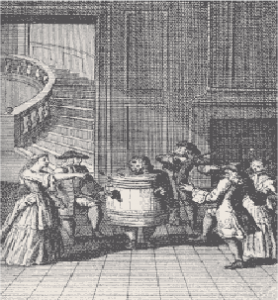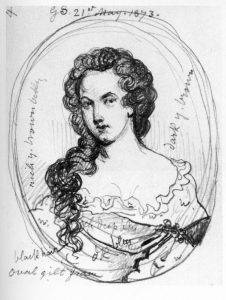10
History of the Restoration
Most people are familiar with the work of William Shakespeare, who wrote from about the 1590s to his death in 1616. Shakespeare and his contemporaries made the theater a common source of entertainment for all people–rich and poor alike. However, just a few decades after Shakespeare’s death, Oliver Cromwell led the charge to make England a Commonwealth, signed the death warrant of King Charles 1, and ruled England from 1649-1658. Cromwell instituted a series of moral laws and outlawed the theater altogether.
The Restoration period began in 1660 when Charles Stuart was invited to take up the English Crown by a nation that had beheaded his father and fought a deeply painful civil war (1642–51). He returned from exile in France and began to rebuild a royal court in which theatre was to play a big part.
Within three months of his return, Charles had granted ‘letters patent’ (legal documents) to his veteran Cavaliers, Thomas Killigrew and William Davenant, giving them exclusive rights to each establish a theatre. The patents stipulated that women (rather than adolescent boys) should play women’s parts.
This video is a bit long and dry, but it is a great synopsis of the historical context for Restoration Comedy:
Restoration Comedy
 Restoration comedy was written and performed from about 1660 to 1700, flourishing in the period after the Restoration of the Stuart monarchy. As a reaction to Cromwell’s reign, the people, including King Charles, rebelled against the morals of the Puritans. This rebellion is clear in the plays produced during the Restoration, which seem to glory in debauchery.
Restoration comedy was written and performed from about 1660 to 1700, flourishing in the period after the Restoration of the Stuart monarchy. As a reaction to Cromwell’s reign, the people, including King Charles, rebelled against the morals of the Puritans. This rebellion is clear in the plays produced during the Restoration, which seem to glory in debauchery.
Some 500 plays survive, though only a handful of them are performed today, and few playwrights have achieved lasting fame. Leading names include William Wycherley (The Country Wife, 1675), George Etherege (The Man of Mode, 1676), Aphra Behn (The Rover, 1677), John Vanbrugh (The Relapse, 1696) and William Congreve (The Way of the World, 1700).
The Theatre Royal in Drury Lane (1663) and the Dorset Garden Theatre in Whitefriars (1671) became the focus for a resurgent interest in writing and staging a new kind of comedy. Playwrights were inspired by exciting advances in theatre design and technology, such as moveable scenery, candlelit chandeliers and footlights.
Audiences came to see themselves reflected in the plays, but such was the disreputable nature of the profession, especially for women, that actors were mainly recruited from the poorest social groups. Intensive training was required to mimic upper-class speech and adopt the correct etiquette with swords, hats, fans and greetings. Everyone knew that they were watching an illusion of high society, and this gave the plays’ themes of masking, gulling and deceit an additional edge. The Restoration also saw the rise of the celebrity actor, such as Elizabeth Barry.
The Audience
The aristocratic upper classes may have laid claim to Restoration comedy, but by the end of the century the audience had diversified considerably. Graded seat prices and seating zones resulted in a sense of class ownership of parts of the playhouse auditorium. Actors enjoyed exploiting the divisions by ‘playing’ to different parts of the house. City merchants, their wives and servants, a growing middle class and a vocal group of fops and critics made up the regulars. In his diary, Samuel Pepys refers to frequent scenes of disorder, which he blamed on the large numbers of ‘cits’ (lower-class citizens), apprentices and ‘mean types’ seated in the gallery. Only Puritans, now on the losing side, stayed away. On stage they were ridiculed, portrayed as mercenary hypocrites bent upon spoiling innocent fleshly pleasures.
There was no concept of a ‘fourth wall’, which made the relationship between players and audience electrifying at times. Audiences adored the simple technique of the ‘aside’, where characters addressed them directly, taking them into their confidence. They preferred predictable plots and exaggerated stereotypes. When disgruntled with a particular play, audiences sometimes became so rowdy that they could close a production down.
The Comedy of Manners
The comedy of manners was Restoration comedy’s most popular sub-genre. Although they ultimately uphold the status quo, these plays scrutinize and ridicule upper-class society’s manners and rules of behavior, providing an up-to-the-minute commentary on class, desire and the marriage market.
The tone is cynical and satirical, while the language and actions are sexually explicit. Characters are driven by lust, greed and revenge, and their goals are limited: fraud, courtship, gulling, cuckoldry. The intricate plots add much to the atmosphere of deceit and moral confusion.
Two Pairs of Lovers
A particularly appealing feature of the Comedy of Manners is the contrast between two pairs of lovers. The ‘gay couple’ are witty and independent, with time to banter and tease their way to choosing a marriage partner. Through them, the complexities of commitment could be explored. Nell Gwyn, mistress to Charles II, was the first actor to play one half of a ‘gay couple’, helping to establish the type as an enduring favorite.
The second couple are constant and unexciting. Their path to true love is thwarted by outside forces, usually in the shape of a blocking character – Don Pedro in The Rover or Lady Wishfort in The Way of the World.
The Function of Wit
Restoration comedy kept all sections of its audience happy by blending wit with ‘low’ humor such as farce and burlesque. In the 17th century, wit meant more than the ability to make people laugh. Wit was governed by a serious playfulness with words and ideas, where language was used in an intellectually stimulating and surprising way. Such language was elegant, structured and subtle. The style in which an original thought was expressed was as worthy of attention as the idea itself. Playwrights would sacrifice pace to allow time for displays of wit between rivals aiming to cut each other down to size, or, more popular still, for the sparring, flirtatious wit between would-be lovers.
The language of wit incorporated a full armory of linguistic devices: double entendre, pun, antithesis, paradox, aphorism, similitude, raillery, repartee, quibble, irony, epigram and conceit. ‘True wits’ were deeply respected for their skillful ability with these techniques.
The Rake
The rake was an invention of Restoration comedy. Seductive, witty and arrogant, he represented a flattering type of male prowess and drive, much admired in court circles. Through the rake, the plays explore the possibility of a sexual freedom which was simply not possible in London society at large, but was more than tolerated at court.
Restoration Comedy and Marriage
 In Restoration comedy the finest couples make the best financial deal for themselves in the marriage market. Mutual attraction, if it exists, is a bonus. In the real world things were not so certain. Some returning Cavaliers had failed to recoup their lands and fortunes and had to widen their search for a wife to include the daughters of the middle class. This sharpened competition for wives placed an extra premium on women’s honor and reputation.
In Restoration comedy the finest couples make the best financial deal for themselves in the marriage market. Mutual attraction, if it exists, is a bonus. In the real world things were not so certain. Some returning Cavaliers had failed to recoup their lands and fortunes and had to widen their search for a wife to include the daughters of the middle class. This sharpened competition for wives placed an extra premium on women’s honor and reputation.
Towards the end of the century, new ideas emerged about the position of women in marriage. Their subservience to their husbands, though fully endorsed in law, was no longer seen as a natural rather than a social circumstance. As the number of women in the audience grew, Congreve (The Way of the World) and other playwrights explored concerns of particular interest to them.
Proviso scenes became increasingly common. These are scenes in which couples debate how best to enjoy or endure the married state. Usually, each gives up some power over the other and forfeits individual rights in order to put unity in marriage first. This writing put forward fresh thinking; perhaps marriage could be an alliance of like-minded, consenting men and women?
Morality in Restoration Comedy
Jeremy Collier wrote a scathing article calling playwrights out on the seeming lack of morality in the plays of this era. Many of playwrights responded with the claim that the bad examples they used in their plays were meant to serve as a warning to people to NOT behave that way, rather than to condone immoral behavior.
The following video will give you a nice overview of the main features of Restoration Comedy.
This site includes some interesting background on women on the Restoration stage and one of the most famous actresses of the time : https://restorationtheater.wordpress.com/
—–
Text adapted from https://www.bl.uk/restoration-18th-century-literature/articles/an-introduction-to-restoration-comedy under CC-BY NC 4.0.
Media Attributions
- Love_in_a_Tub
- 1024px-Aphra_Behn
